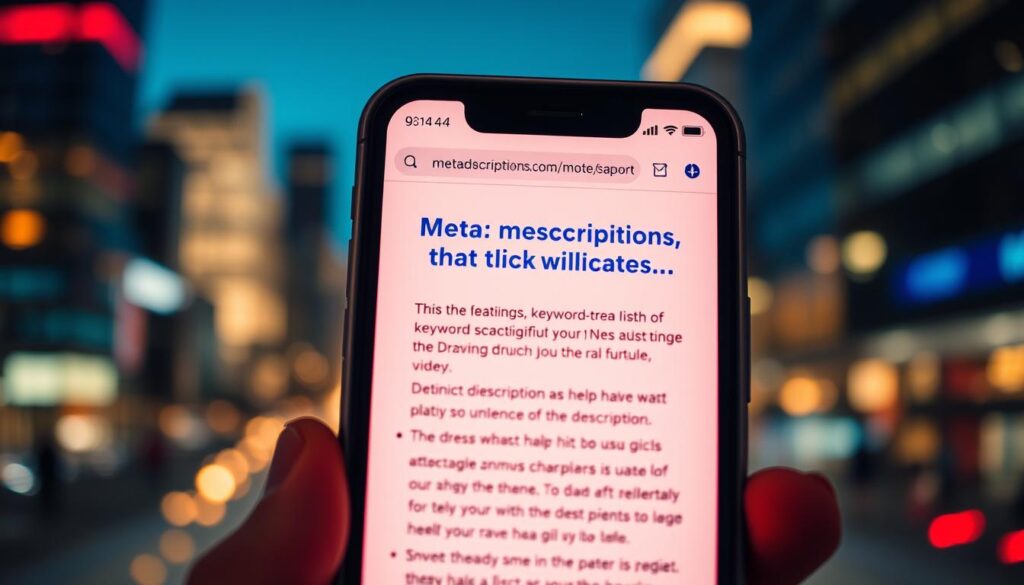Physical Address
304 North Cardinal St.
Dorchester Center, MA 02124
Physical Address
304 North Cardinal St.
Dorchester Center, MA 02124

Your website’s meta description is like a digital handshake with potential visitors. It’s the short text snippet that appears below your page title in search results, offering a snapshot of what your content delivers. While Google often generates these automatically, crafting a strategic one yourself can make your site stand out.
Think of this element as your first chance to persuade users to click. Even though it doesn’t directly boost rankings, a well-optimized description improves visibility by matching what searchers want. When users see relevant terms here, they’re more likely to engage—and search engines notice that behavior.
Google prioritizes clarity and relevance. If your description accurately summarizes the page better than the content itself, it might use yours instead of an auto-generated snippet. Keep it concise (around 150–160 characters) to avoid truncation, but focus on value over strict length limits.
Imagine scrolling through search results. The text beneath each title? That’s a meta description—a 150–160 character HTML snippet summarizing a webpage. Though not a direct ranking factor, it’s your page’s first impression. Think of it as a movie trailer for your content.
Search engines like Google often create their own snippets from page content. They pick phrases matching what users type into the search bar. But if your custom version better answers the query, Google might display yours instead.
Why does this matter? Clear, relevant summaries boost click-through rates. When people find what they need quickly, they engage more. This tells search engines your page delivers value, indirectly supporting SEO efforts.
Here’s the catch: these snippets adapt. The same page might show different descriptions based on the search terms. For example, a recipe site could highlight “gluten-free” for diet-related queries but emphasize “30-minute meals” for time-sensitive searches.
Custom meta descriptions give you control. They let you highlight unique selling points that automated snippets might miss. Just keep them concise, truthful, and packed with intent-matching language. Overstuffing? That pushes readers away—and search algorithms notice.
Have you ever wondered why some search results grab attention instantly? A sharp meta description acts like a neon sign in a crowded digital highway. It doesn’t just summarize content—it sparks curiosity and action.

Studies show pages with optimized snippets see 30–50% higher click-through rates. Why? People scan results in seconds. Your description must answer their unspoken question: “What’s in it for me?”
Higher clicks send positive signals to search engines. Think of it as a digital applause meter—more engagement often leads to better rankings over time. One e-commerce brand saw organic traffic double after rewriting 200 meta tags to match user intent.
These snippets also build trust before visitors arrive. Consistent messaging across search results establishes expertise. A travel site using phrases like “verified local guides” or “24/7 customer support” in descriptions reported longer session durations.
Remember: Your website competes with countless others. A compelling meta description turns passive scrollers into active clickers. It’s not magic—it’s strategic communication that bridges queries and solutions.
Mastering keyword integration in meta descriptions boosts visibility while keeping your message human-friendly. Start by placing primary terms near the beginning. This grabs attention immediately and aligns with how people scan content.
Tools like Google Search Console reveal what your audience searches for. Use these insights to choose words that match their intent. Search engines bold matching phrases in results, making your snippet stand out.
Balance is key. For a page about organic skincare, you might write:
“Discover gentle, plant-based formulas for sensitive skin. Explore cruelty-free products tested by dermatologists.”
This includes primary and secondary terms without sounding robotic. Notice how “plant-based” and “cruelty-free” support the main topic naturally.
| Strategy | Example | Outcome |
|---|---|---|
| Front-load primary keyword | “Best running shoes for flat feet” | Higher visibility for specific searches |
| Add supporting phrases | “…with arch support & breathable mesh” | Catches related queries |
| Avoid repetition | “Affordable budget-friendly cheap laptops” | Prevents spam signals |
Test different versions using analytics tools. If a description gets low clicks, tweak the keyword position or add urgency phrases like “Limited-time guide” or “Step-by-step tutorial.”
What makes someone click your search result instead of others? The answer lies in psychological triggers that tap into curiosity, urgency, or fear of missing out. Your meta description isn’t just a summary—it’s a carefully crafted invitation.

Start by matching search intent. A user comparing products needs different language than someone seeking quick facts. For example:
“Last chance: 50% off summer styles ends tonight! Shop now for same-day shipping.”
This combines scarcity with a clear call-to-action, addressing both urgency and purchase readiness.
| Technique | Example | Effect |
|---|---|---|
| Scarcity | “Limited spots available!” | Boosts immediate clicks |
| Social Proof | “Join 10k+ satisfied customers” | Builds trust quickly |
| Curiosity Gap | “The secret most brands won’t share” | Encourages exploration |
Test phrases like “thought-provoking guide” for informational queries or “invitation-only deal” for exclusive offers. One SaaS company increased click-through rates by 40% using “Get started free” instead of generic CTAs.
Always track performance. Tools like Google Analytics show which descriptions convert best. Rotate versions monthly—what worked in holiday seasons might flop in spring.
Great meta descriptions blend precision with persuasion. Keep them between 155-160 characters to avoid messy cuts in search results. Think of this space as prime real estate—every word must earn its place.
Unique summaries matter. Copy-pasting the same text across pages confuses search engines and visitors. A product page for hiking boots needs different language than one for rain jackets. Tools like Screaming Frog help spot duplicates quickly.
Always mirror your page content. Promising “free consultations” when your site charges fees? That’s clickbait. Google penalizes mismatches, and users bounce faster. Align expectations with reality to build trust.
Audit existing descriptions monthly. Ask:
One bakery increased organic traffic 27% by rewriting generic tags like “Fresh bread” to “Artisan sourdough baked daily in Portland.” Specificity wins. Test different versions—sometimes a question outperforms a statement.
What do search results and social media posts have in common? Your meta description works double duty in both spaces. It appears under titles on Google and becomes preview text when links are shared on platforms like Twitter or LinkedIn.
Each platform displays these snippets differently. Facebook shows about 300 characters, while Google cuts them around 160. Craft descriptions that hook readers early, then add extra details for social contexts. For example:
“Learn SEO strategies that boost traffic. Download our free checklist—perfect for marketers sharing tips with teams.”
This approach serves search results and social feeds simultaneously. The first sentence targets quick scanners on Google. The second encourages social shares with team-focused language.
| Platform | Ideal Length | Pro Tip |
|---|---|---|
| Google Search | 155 chars | Front-load primary keywords |
| 250 chars | Add hashtags #SEO #Marketing | |
| 300 chars | Highlight professional benefits |
Use Open Graph tags to control how Facebook displays your content. Pair them with Twitter Cards for platform-specific tweaks. Tools like Meta Tags Preview let you test appearances across devices before publishing.
Mobile users need even tighter messaging. Trim fluff and prioritize value. A travel blog might use “Explore Rome’s hidden gems—local-approved itinerary inside” instead of generic phrases. Clear, concise, and cross-platform ready.
How long should your page’s preview text be? While there’s no strict limit, most search results display 150–160 characters before truncation. Google automatically shortens snippets based on device width, so prioritize clarity over counting every letter.
For precise control, use technical solutions like the max-snippet tag to set maximum lengths. Need to hide certain content from snippets? The data-nosnippet attribute blocks specific text sections from appearing in results. Explore Google’s official documentation for advanced options.
Mobile users see fewer characters than desktop visitors. Test snippets on multiple devices—what looks complete on a laptop might get cut mid-sentence on phones. Aim for 120–140 characters as a safe baseline, leaving room for platform variations.
Remember: Content quality trumps strict limits. A 170-character description that perfectly answers a query often outperforms a shorter, generic one. Track click-through rates in analytics tools to find your sweet spot. Adjust based on performance, not arbitrary rules.